Ultrasound is the optimal imaging modality for the evaluation of the uterus and preferred as the first imaging modality used when patient symptoms suggest uterine abnormalities. This GYN Ultrasound of Nonpregnant Abnormal Uterus Advanced Clinical Module Part 2 overviews the classifications and potential causes behind abnormal uterine bleeding and discusses techniques to evaluate the endometrium. The course thoroughly looks at imaging characteristics, diagnostic criteria, relevant Doppler adjuncts, and widely accepted management guidelines of pertinent endometrial conditions; these conditions include endometrial polyps, submucosal leiomyomas, endometrial adhesions, retained products of conception, arteriovenous malformations, endometrial cancer, endometrial hyperplasia, and the effect of tamoxifen on the endometrium. This module primarily focuses on image acquisition by transvaginal approach and 3D ultrasound.
This activity has been planned and implemented in accordance with the accreditation requirements and policies of the Accreditation Council for Continuing Medical Education (ACCME) through the joint providership of the American College of Emergency Physicians, the Illinois College of Emergency Physicians, and SonoSim, Inc. The American College of Emergency Physicians is accredited by the ACCME to provide continuing medical education for physicians.
The American College of Emergency Physicians designates this enduring material for a maximum of 4.5 AMA PRA Category 1 Credits™. Physicians should claim only the credit commensurate with the extent of their participation in the activity.
Approved by the American College of Emergency Physicians for a maximum of 4.5 hours of ACEP Category I credit.











